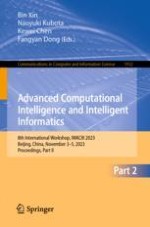2024 | Buch
Advanced Computational Intelligence and Intelligent Informatics
8th International Workshop, IWACIII 2023, Beijing, China, November 3–5, 2023, Proceedings, Part II
herausgegeben von: Bin Xin, Naoyuki Kubota, Kewei Chen, Fangyan Dong
Verlag: Springer Nature Singapore
Buchreihe : Communications in Computer and Information Science
